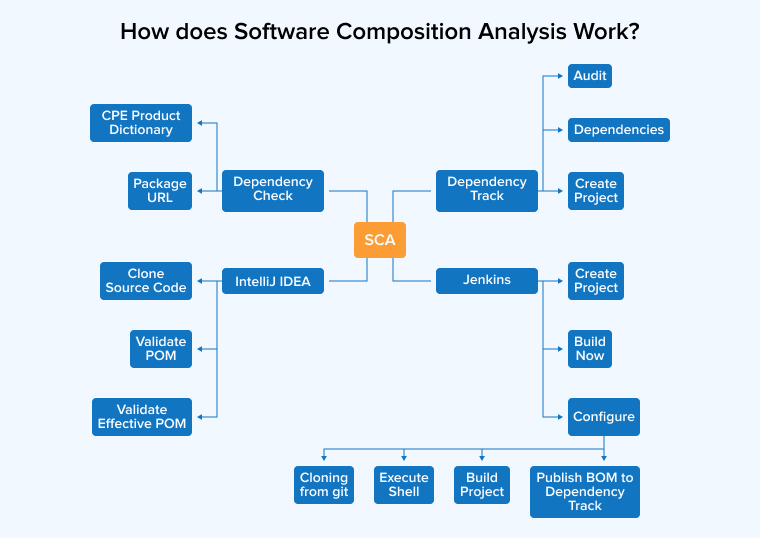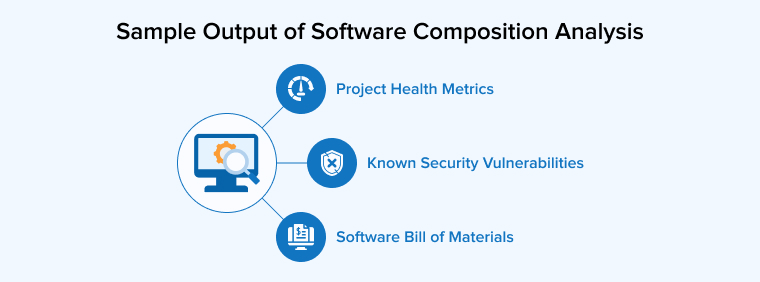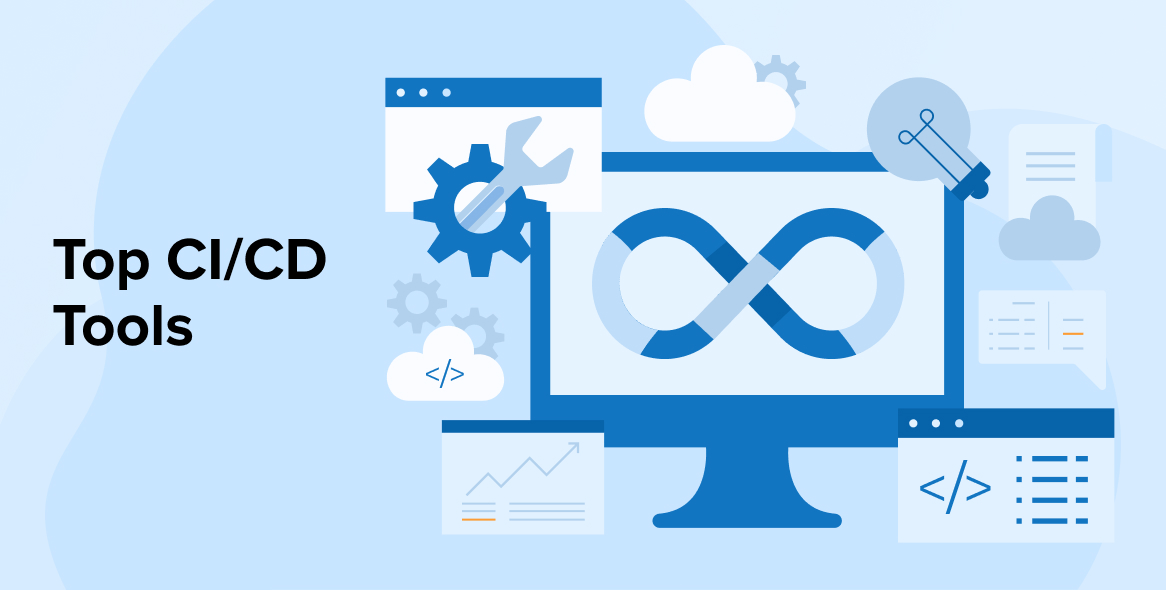
Nowadays, the majority of the businesses and software developers prefer open-source code and components as it costs less and is easily available everywhere. When dealing with open source, one must manage the code and its components to eliminate security vulnerabilities. And generally, developers are busy creating engaging, user-friendly, and reliable software applications faster than ever to fulfill clients’ demands. And as the majority of them are working on one-source code to quickly add functionalities and deliver the application to the clients, they might not be able to find out the critical issues and risks that the open-source components bring to the application. This is where the need for software composition analysis arises.
Software composition analysis (SCA) enables the development teams to find potential security vulnerabilities and work on them quickly to offer the best software application to their clients. To learn more about SCA and how SCA benefit organizations identify bugs, let’s go through this blog.
1. What is Software Composition Analysis (SCA)?
Software composition analysis is a process that enables the developers to safely use open-source packages without the risk of exposing organizations to legal or any other unnecessary vulnerabilities and compliance issues.
This procedure allows developers to automate visibility into open-source software (OSS) for addressing security, risk management, and license compliance issues. This means that when the open source use in software rises in various industries, the need of tracking all the components present in the software increases in order to protect the companies from open-source issues and security vulnerabilities. The primary motivation for this is that, during the software creation process, manual tracking is challenging to carry out, necessitating the imperative of automation. Automation not only helps in scanning the source code but also helps with dependencies and binaries.
In addition to this, software composition analysis comes with three core capabilities and they are –
- SCA enables the developers to create a software bill of materials (SBOM). And it can help in establishing an accurate inventory.
- With the help of software composition analysis, discovering detailed information about the issues or vulnerabilities in the source code of the open-source software is possible and this also helps in offering remediation suggestions.
- It also helps in verifying the requirements of the license compliance requirements by specifying where the open-source software originated from and what it is all about.
2. How does Software Composition Analysis Work?
Software Composition Analysis is a very simple and crucial process that is used by custom software development companies. It works by running various automated scans on the source code. With the help of this approach, the developers can easily create an analysis of all the code base vulnerabilities. The output of this analysis is a software bill of materials (SBOM) that specifies all the components of the created or existing software and their licenses.

Besides this, the scanning process of this approach inspects all the system files to find out whether there are any third-party components vulnerabilities or not. It also offers insights into the dependencies that are open-source. SCA then compares the SBOM list that came as an output with other vulnerability databases and this helps in specifying all the crucial vulnerabilities of the system. After this, SCA can be used in the software development lifecycle to get suggestions about how to resolve harmful vulnerabilities.
In addition to this, software composition analysis tools also offer complete open-source project health metrics analysis. For instance, there is a company that requires you to create a compliance baseline and comprehensive security. If such companies use SCA tools they can have consistent security and license compliance policies that can be easily manageable.
3. What are the Benefits of SCA?
Organizations of all sizes and industries utilize digital technological platforms. They are using applications that are specifically designed to meet different use cases within their specialized fields. But sometimes it isn’t possible for all the companies to invest so much in the app development process, especially for small businesses. Therefore, they try to use open-source components that are available in the market for free and can be modified as per the business requirements.
Nowadays, more and more software developers & development teams are using open-source components to create modern applications for their own use or for their clients. But using these components is not safe and secure. This is why software component analysis tools are used. A software composition analysis tool can help any development team to find all the open-source components in the developed application and notifies how secure their use is.
This approach not only helps the software development teams but also enables security teams to find licensing issues and security risks at a faster rate. Knowing the vulnerabilities faster can help in performing automated scanning and lowering remediation costs to detect and fix vulnerabilities with less human effort. Besides this, there are some other major benefits of using software composition analysis tools and they are:

3.1 Innovation
One of the biggest benefits that come along with the usage of the software composition analysis approach is that when the development teams are using open-source components, it offers great freedom and flexibility with time and cost-saving benefits. This allows the developers to contribute their time toward innovations that are required to sustain market demands. Basically, with the help of SCA, product innovation is possible in safer ways by ensuring effective license management.
3.2 Eliminating Business Risks
The majority of the businesses generally don’t know everything about all the open-source components they are using or have used in the application which means that any of the components can be from a third-party vendor. But if the developer doesn’t know what’s going on in the application, the chances of inherent risks are always there. This is why software composition analysis must be performed. It understands all the open-source components which means that if any issue occurs in the system, it can help in eliminating it by giving remediation suggestions to the developers. It also suggests automating the processes that are safe from risks like license compliance and security.
3.3 Quick Vulnerability Remediation
Another major benefit of using SCA tools is that they help businesses and individuals quickly rectify the issues and vulnerabilities that are present in the application. The software composition analysis approach comes with the capability to automatically detect the location of the vulnerability and then give suggestions to fix it. With the help of SCA, developers can also get information on how to implement the fix. Besides this, any software composition analysis tool can start the remediation process automatically based on the severity of the vulnerability and then it detects the issues, scores the vulnerability, releases the new version, and vulnerability policies are created after taking all these factors into consideration.
Basically, with the help of SCA, the developers can keep all the open-source app components in the system and get excellent & quick remediation for vulnerabilities.
3.4 Vulnerability Prioritization
With the help of modern software composition analysis solutions, the developers can now see that the gap between discovering issues and remediation is getting closer. This implies that SCA possesses the capabilities necessary to prioritize open-source vulnerabilities. This is possible with automatic and proactive identification of security issues and risks in the software supply chain. After the SCA tool catches the risk factors and offers the data to the developers, they can prioritize which issue to address and when. This approach not only saves security teams’ time but also helps them with getting alerts on vulnerabilities that are severe and needs instant attention.
3.5 Faster Time-to-Market
Nowadays, the majority of the application is using open-source components as they are readily available in the market and are cost-efficient. The usage of such components helps developers in coding the application and deploying it faster in order to meet the client’s expectations and demands. But in order to deliver a secure product in spite of using open-source components the developers need to use SCA tools. These tools ensure that the applications not only meet the legal obligations as per the expectations but also are vulnerability free.
4. What to Look for While Selecting a SCA Tool?
After learning all about software composition analysis and how SCA tools benefit custom software development companies, now have a look at the key factors that need to be taken into consideration while choosing the best SCA tool for your client. The reason behind knowing these factors is that there are many SCA tools available in the market and choosing the right now that fits your specific requirements is difficult.
Here we will go through some points and basic questions that are must to remember and ask yourself or the company offering SCA tools before choosing any software composition analysis tool for your software development lifecycle project.
4.1 How is this SCA Tool for Component Detection?
This is a must ask question when it comes to choosing a good SCA tool. It should possess a comprehensive database that assists the development team in identifying the open-source components utilized in an application. The more components a tool can detect, the chances of discovering security vulnerabilities increase and then the team can fix all the issues to offer the best application to the clients. Therefore, checking how comprehensive the tool is when it comes to detecting the components in comparison to other tools is necessary.
4.2 Is the Tool Developer-Friendly?
When it comes to software development and deployment, generally all the developers in the team are busy creating code that helps in delivering the end goals, working to fulfill the design requirements and client needs. In this case, the development team requires a tool that can help them to iterate quickly when required and offer better code quality. And here, if an organization chooses the wrong SCA tool which is not developer-friendly, they will find it difficult to work with the tool and embrace all its features as understanding the tool will take a lot of their time which will eventually reduce the productivity of the developers. Therefore, any software composition analysis tool that an organization selects must be user-friendly which helps the developers to get their hands on it faster.
4.3 What is the Reporting Quality of the Tool?
Another important question to ask while selecting the SCA tool is what is its reporting quality. This is important as reporting is a must-have feature when the development team decides to have an SCA tool. Though the reporting capabilities of each tool might differ before choosing the one for your firm, you must compare reporting capabilities of potential tools. This can help in finding out which tool will offer qualitative reports that can eventually help developers to work on it and fix vulnerabilities.
4.4 How about Vulnerability Identification and Remediation Functions?
The ideal SCA tool offers a comprehensive vulnerability detection functionality that helps the development team in identifying open-source components. Once identified and a report is generated, the tool also provides a list of remediation measures. These enable developers to promptly address the issues and safeguard the application using the appropriate methods. This means that the tool you choose for your project must offer proper vulnerability identification and remediation functionalities.
4.5 How about Integrations with Other Environments?
Any software development company must go with the software composition tool that offers seamless integration with the current build environment. This helps in eliminating any hassles while improving the quality of the application. Besides this, the tool must also be able to connect itself with other services and tools like security systems, SCMs, IDEs, containers, and more.
4.6 How Many False Positives?
Generally, an SCA tool doesn’t offer an output that has more false positives. But still, some tools do and to avoid the usage of such tools, the developers must perform a proof-of-concept that can help them evaluate the signal-to-noise ratio of the potential tool. Essentially, the best tool to work with is determined by its minimal false positives. This selection process involves comparing the prospective tool with others available in the market.
5. Conclusion
As seen in this blog, Software Composition Analysis (SCA) not only helps in improving the application’s security levels but also helps in enhancing compliance by detecting open-source components that have vulnerabilities and alerting developers to fix them. SCA tools save the application from cyberattacks and safeguard all the critical information present in the application about the client’s business and end-users. It also enables the software development teams to reduce the cost that goes behind app development and vulnerability detection. It also helps in enhancing the business’s agility. Basically, by implementing the right SCA tool as per the business requirements of your clients, you can get the best results.




Comments
Leave a message...